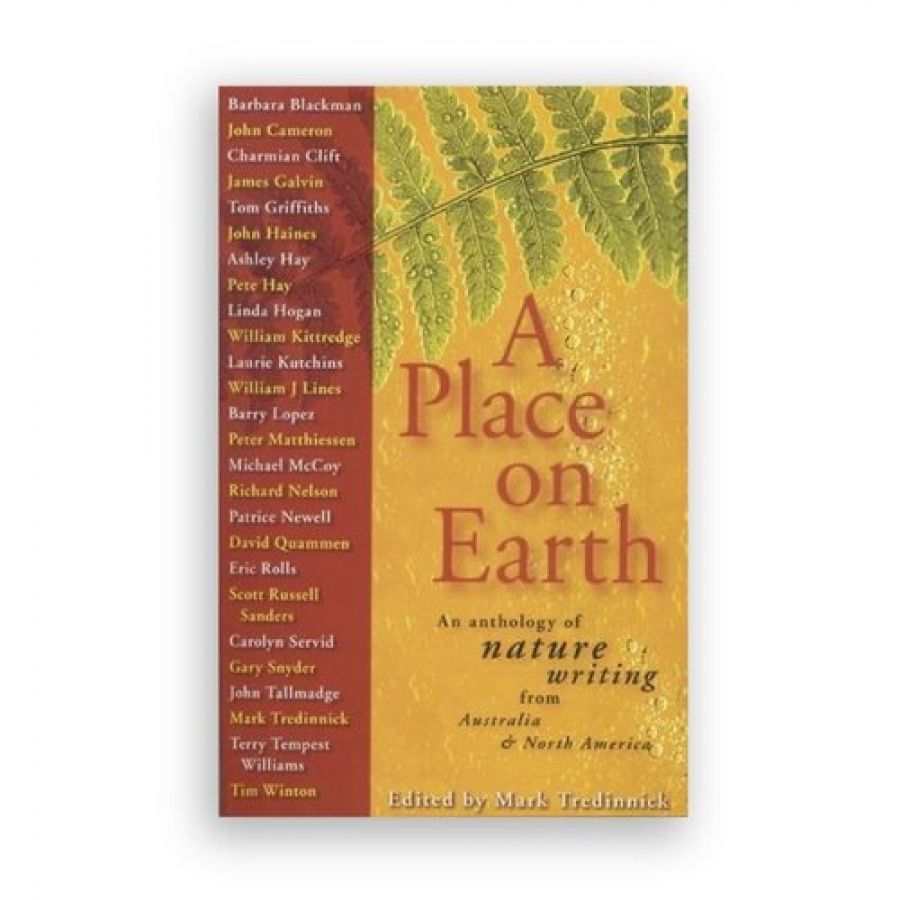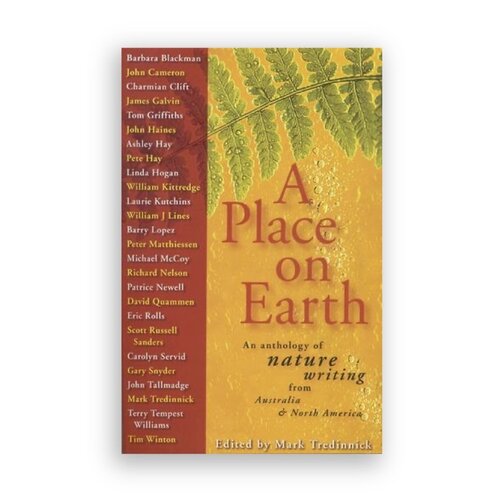
- Free Article: No
- Contents Category: Reviews
- Review Article: Yes
- Online Only: No
- Custom Highlight Text:
When the Picador Nature Reader was published several years ago, it included only one contribution by an Australian: an excerpt from David Malouf’s An Imaginary Life. It’s a beautiful piece of writing, but it is not set in Australia. It struck me at the time that for a culture so deeply embedded in, and concerned with, the land we have little in the way of nature writing.
- Book 1 Title: A Place on Earth
- Book 1 Subtitle: An Anthology of Nature Writing from Australia and North America
- Book 1 Biblio: UNSW Press, $29.95 pb, 268 pp
- Book 1 Cover Small (400 x 600):

- Book 1 Cover (800 x 1200):

Some of our most powerful evocations of the natural environment have been provoked out of a deep sense of unease. But where is our literature that celebrates the land, our equivalent of Annie Dillard finding metaphor and mystery in the tracks and tides of the natural world, or Loren Eisely pursuing a strand of thought into some canyon or swamp, finding traces of the troubled primate whose consciousness has given rise to the contemplation of such things? There are many Australians with a deep affinity for the place in which they live, but on the whole, they don’t write about it. It seems to require the grit of unease to start the words spinning out onto the page. And it’s also a matter of critical mass. Too few of us actually live outside the cities, fewer still with the circumstances and skills to write about it.
Mark Tredinnick’s introductory essay to A Place on Earth is a thought-provoking and comprehensive exploration of the reasons for the dearth of nature writing in Australia, as compared to its profusion in America. He cites historical circumstances, geography and patterns of settlement, urbanisation, the absence of a tradition of lyric essay writing, the poor fit between a language that evolved elsewhere, and a landscape full of silences.
A point he doesn’t mention, and one I think worth raising, is that the gap left by writers has been filled by visual artists, painters in particular. It is as if our written language has not caught up with the subtlety and nuances, the intelligent multilayered silences, of painting. It is no accident that the most comprehensive stories of place are embedded in the extraordinary flowering of Aboriginal painting, and almost all the Australian contributors to the anthology make some reference to indigenous people, in marked contrast to the American essayists. The Australian sense of the sublime exists, but it is provisional, balanced always by something that evades language, something forever registering at the edge of voice and vision.
By putting a selection of Australian writers beside a rollcall of North American nature writers – Peter Matthiessen, Barry Lopez, David Quammen, William Kittredge, Richard Nelson, Linda Hogan, and others – Tredinnick provides a context for Australian nature writing.
Among the Australians, the writing of Eric Rolls adheres most fully to the tradition of the lyric essay, and Tredinnick’s own contribution sits firmly within this genre. Ashley Hay contributes a fine, discursive piece on ultramarine, the blue of the eastern seaboard. The contradictions between human and non-human requirements animate the work of Michael McCoy and Peter Hay, and Hay’s disgruntled and self-questioning voice is bracing and entertaining. For Barbara Blackman, ‘living anchored offshore’ by her blindness, nature is both metaphoric and intensely physical. Tom Griffiths is one of the finest writers on environmental issues in Australia, and, in ‘Cooper Dreaming’, he writes of encounters with a number of pastoralists who are working with their country. Like Francis Ratcliffe before him, ‘He regarded people not only as components of the ecosystem, but also as sources of knowledge about it.’
I read the collection in two ways, paying particular attention to the Australian contributions and Tredinnick’s stated intention ‘to encourage a place-based literature, an antipodean nature writing, in my own homeland’, and simply reading, without making distinctions. At this second level, it was Laurie Kutchin’s ‘Wind Ensemble’ that struck the deepest chord of recognition, the rhythms and ambiguities of poetic language invoking the Wyoming landscape of her childhood, from which the practicalities of work and family have exiled her, but which ‘Mysterious and potent as archetype, fierce as any erosional force ... keeps carving me’.
A Place on Earth is a homage to the relationship between people and landscape, and a significant and timely contribution to the burgeoning Australian literature of place. For anyone who cares about the places in which we live, and the various ways in which we care for and respond to them, this anthology is a source of pleasure, provocation, and fine, thoughtful writing.


Comments powered by CComment